Reading: The Reagan Years
The Reagan Years
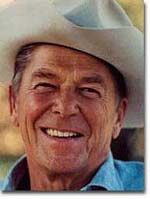
Ronald Reagan swept into office in 1980 with a sizeable victory over incumbent Jimmy Carter. Tax cuts and military spending were the hallmark of his administration.
Americans were fed up.
In 1980, confidence in the American economy and government hit rock bottom. Looking for a change and the promise of a better future, voters turned to RONALD REAGAN for answers.
His message was clear. Government has become too big and needs to be trimmed down to size. Taxes are insanely high and need to be cut to stimulate growth and investment. Military spending should be increased to fix the degenerating state of the American war machine. Morality and character need to be reemphasized in American life. The United States is still the largest superpower in the world with the best system of government. It's time to feel good about being an American again.
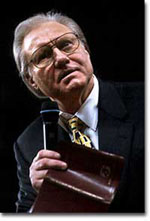
Before the news of his involvement in a tawdry sex-scandal broke, Jimmy Swaggert had been one of America's most popular televangelists. In 1986, the last full year before the scandal, his television ministry raised nearly $142 million dollars.
Reagan's election brought a dramatic change to the federal government. No president, Republican or Democrat, had attempted to reduce the size of the federal government since Franklin Roosevelt initiated his New Deal. The tax cut that was handed to the American people benefited wealthy Americans most, with the hope that their increased income would trickle down to poorer Americans — the so-called trickle-down theory. The economic stagnation of the 1970s did come to an end, but at the cost of huge federal deficits and the increasing poverty rate.
The 1980s were a decade of scandals. The Iran-Contra Scandal proved that White House officials were willing to break the law to carry out their political agenda. Religious leaders like JIM BAKKERand JIMMY SWAGGERT became mired in dirty sex scandals. Moral turpitude ended the political career of Colorado Democrat GARY HART, who might well have been president one day. A SAVINGS AND LOAN SCAM fleeced American taxpayers for billions and billions of bailout dollars.
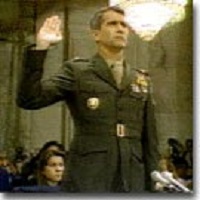
The Iran-Contra scandal featured top government officials selling arms to Iran and using the profits to back guerillas in Nicaragua. Oliver North, seen here testifying before the Iran-Contra committee, was the chief negotiator of these deals.
American lifestyles changed dramatically during the 1980s. Cable television introduced a whole palette of new programming for the discriminating viewer. Compact discs replaced records as the most popular medium for recorded music. Banking became more convenient with the proliferation of automatic teller machines. Businesses and individuals rushed to purchase personal computers that held the promise of radically simplifying difficult tasks.
As the decade came to a close, it became clear that the malaise of the 1970s was over. The United States received a boost of confidence when the Cold War came to an end in 1991. The menace of a threatening Soviet Union now belonged to history, and the United States claimed the status of the only remaining superpower in the world.
"Morning in America"
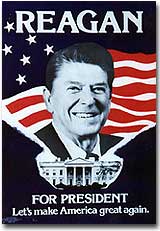
Ronald Reagan swept into office in 1980, capturing nearly 10 times as many electoral votes as his incumbent opponent Jimmy Carter. The Republican Party was also able to ride Reagan's coattails to capture their first majority in the Senate since 1954.
The long national nightmare was over.
The United States was filled with hard-working, God-fearing citizens who cared about their fellow Americans. Inflation and unemployment were problems of government, not the national character. Vietnam was over; America was the most powerful nation in the world. The Soviet Union was an evil empire. Old-fashioned initiative and ingenuity would maintain America's competitive edge in commerce.
These themes soothed a nation sick with the malaise of the 1970s. When all had seemed lost, a grandfatherly figure stepped forth and optimistically reassured Americans that the age-old beliefs they held about the grandeur of the United States were not myths.
This man, Ronald Wilson Reagan, understood the sprit of the times, and his message, personality, and politics dominated the 1980s.
Traditionally, working-class Americans, Southerners, Catholics, and urban dwellers had strong ties to the Democratic Party. The Republicans relied heavily on support from the rural Midwest, Protestant leaders, and wealthier voters. Ronald Reagan built a new coalition for the Republican Party in his quest for the Presidency in 1980.
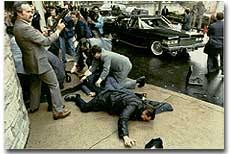
Chaos ensues following an assassination attempt on Ronald Reagan in March 1981. Reagan was hit in the chest but managed a quick recovery, returning to the White House less than two weeks later.
Working Americans were shocked to see unemployment rates nearing double digits. Inflation was pushing the middle class into tax brackets previously reserved for the affluent classes. Reagan promised to reduce their level of misery with sound fiscal policy. Southerners disgruntled by affirmative action and busing found friendly ears in the Reagan campaign. The endorsement of Reagan by the Protestant establishment did not deter devout Catholics from voting Republican, since Reagan promised to oppose abortion rights and promote family values.
Crime-plagued city denizens looked to Reagan for comfort as he portrayed himself as the law and order candidate. Americans across demographic lines were warmed by his promises for a stronger America domestically and overseas. Very quickly, these "REAGAN DEMOCRATS" crumbled the old alignment. Jimmy Carter, his opponent in the 1980 election, never stood a chance.
Reagan's victory over the incumbent Carter was an electoral vote landslide. He tallied 489 votes to Carter's 49. The Republicans also captured a majority of the Senate for the first time since 1954. Analysts point out that this perceived mandate might have been overstated. Voter turnout was the lowest in the history of Presidential elections. Liberals argued that people were not voting for Reagan's conservative agenda as much as they were voting against Jimmy Carter. During his re-election campaign, Carter endured an approval rating of 23 percent — lower than Richard Nixon's in the darkest days of Watergate!
The new President seemed to be in the right place at the right time. Within hours of his inauguration, Iran released the American hostages that had been held for 444 days. Dubbed "THE GREAT COMMUNICATOR," Reagan had a smile and a confidence that comforted many. At the age of 69, he was the oldest President ever to take office, but he exuded a youthful vitality that obscured his years.
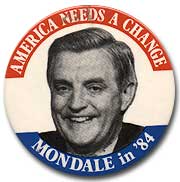
The "Reagan Revolution" continued in 1984 as Reagan defeated former Vice President Walter Mondale in a landslide victory. Mondale and his running mate Geraldine Ferraro managed only 13 electoral votes to Reagan's 525.
Even an assassination attempt worked in his favor. When JOHN HINCKLEY put a .22 caliber bullet in Reagan's chest within two months of his inauguration, he took it all in stride. "I hope you're all Republicans," he quipped to the physicians that greeted him at the hospital. His popularity soared.
Charges that he had little control over his staff and a less than functional understanding of many matters of policy fell mostly on deaf ears. He earned a reputation as the "TEFLON PRESIDENT" — no scandal could stick to him.
In 1984, Reagan won a smashing re-election campaign over WALTER MONDALE. Democrat Mondale, running with the first woman nominee for Vice-President, Geraldine Ferraro, won only his home state of Minnesota and the District of Columbia. A 1984 Reagan campaign as declared proudly, "It's morning in America." Whether the claim was fact or fiction, American voters accepted Reagan's assurances and enthusiastically cried for a second term.
Reaganomics
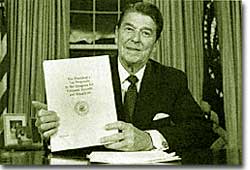
President Ronald Reagan unveils a new tax program, calling it "a second American Revolution for hope and opportunity." Upon taking office, Reagan called for a phased 30% tax cut, but Congress would only agree to a 25% cut.
The media called it Reaganomics.
During the campaign of 1980, Ronald Reagan announced a recipe to fix the nation's economic mess. He claimed an undue tax burden, excessive government regulation, and massive social spending programs hampered growth. Reagan proposed a phased 30% tax cut for the first three years of his Presidency. The bulk of the cut would be concentrated at the upper income levels. The economic theory behind the wisdom of such a plan was called SUPPLY-SIDE or TRICKLE-DOWN ECONOMICS.
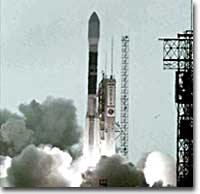
By using laser-equipped satellites, Ronald Reagan's Strategic Defense Initiative hoped to shield the United States from a Russian missile attack. Here, a rocket sends a military satellite into the heavens.
Tax relief for the rich would enable them to spend and invest more. This new spending would stimulate the economy and create new jobs. Reagan believed that a tax cut of this nature would ultimately generate even more revenue for the federal government. The Congress was not as sure as Reagan, but they did approve a 25% cut during Reagan's first term.
The results of this plan were mixed. Initially, the FEDERAL RESERVE BOARDbelieved the tax cut would re-ignite inflation and raise interest rates. This sparked a deep recession in 1981 and 1982. The high interest rates caused the value of the dollar to rise on the international exchange market, making American goods more expensive abroad. As a result, exports decreased while imports increased. Eventually, the economy stabilized in 1983, and the remaining years of Reagan's administration showed national growth.
The defense industry boomed as well. Reagan insisted that the United States was open to a "WINDOW OF VULNERABILITY" to the Soviet Union regarding nuclear defense. Massive government contracts were awarded to defense firms to upgrade the nation's military. Reagan even proposed a space-based missile defense system called the STRATEGIC DEFENSE INITIATIVE. Scientists were dubious about the feasibility of a laser-guided system that could shoot down enemy missiles. Critics labeled the plan "STAR WARS."
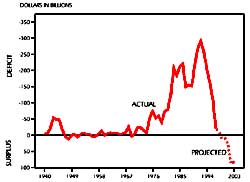
Ronald Reagan's increased spending and accompanying tax cuts resulted in dramatic budget deficits during the 1980s. A deficit occurs when spending exceeds revenues in any year. The drop you see at the end of this chart represents recent attempts to achieve a "balanced budget" — a spending plan where the funds available for use equal the funds spent by the federal government.
Economists disagreed over the achievements of REAGANOMICS. Tax cuts plus increased military spending would cost the federal government trillions of dollars. Reagan advocated paying for these expenses by slashing government programs. In the end, the Congress approved his tax and defense plans, but refused to make any deep cuts to the welfare state. Even Reagan himself was squeamish about attacking popular programs like Social Security and MEDICARE, which consume the largest percentages of taxpayer dollars. The results were skyrocketing deficits.
The national debt tripled from one to three trillion dollars during the REAGAN YEARS. The President and conservatives in Congress cried for a balanced budget amendment, but neither branch had the discipline to propose or enact a balanced budget. The growth that Americans enjoyed during the 1980s came at a huge price for the generations to follow.
Foreign and Domestic Entanglements
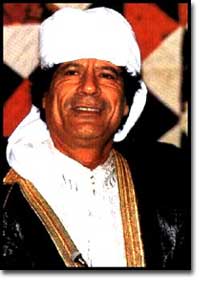
U.S. planes attacked Libya in 1986 after evidence surfaced that Libyan terrorists were responsible for a discotheque bombing in West Berlin. Libyan leader Muammar el-Qaddafi (above) survived the attack, although his home was targeted.
Ronald Reagan, Cold Warrior.
Before he became President, he set the tone for relations with the Soviet Union by labeling the USSR an "EVIL EMPIRE." Around the world, communism seemed to be spreading. Soviet troops were in Afghanistan. Nicaragua was led by a Soviet-backed SANDINISTA government. Communist guerillas threatened to take over in neighboring EL SALVADOR. Cuban-backed troops waged a successfulINSURGENCY IN ANGOLA. The age of détente was over.
Reagan hoped to negotiate with the Soviet Union, but believed he could only achieve concessions if dealing from a position of superiority. His increase in military spending would force a similar increase on the part of the Soviet rivals. In addition to upgrading all three branches of the American strategic defense, he proposed a bold new scheme to defend the United States mainland from any incoming ballistic missiles. This Strategic Defense Initiative (SDI) drew criticism from liberal Democrats who deemed it too costly and from scientists who questioned its feasibility.
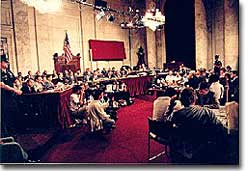
The Iran-Contra Committee convened in 1987 in an attempt to learn more about the secret funding of the Nicaraguan contras. No link could be made to President Reagan, who replied, "I don't remember" to most questions about his involvement.
When MIKHAIL GORBACHEVassumed leadership of the USSR in 1985, proclaiming a new policy of openness, Reagan believed it was time to act. The two leaders agreed in principle to an Intermediate Nuclear Forces treaty in 1987, which for the first time eliminated an entire class of existing nuclear weapons.
Around the globe, Reagan was determined to vanquish the specter of Vietnam. He believed the United States could ill afford to sit passively while communism expanded aggressively. He announced the REAGAN DOCTRINE, which pledged American support to "FREEDOM FIGHTERS" opposing Communism any where on the globe. Funds and CIA training were awarded to the government of El Salvador to help defeat communist guerillas. After left-leaning revolutionaries took over the island of Grenada in 1983, Reagan dispatched the Marines to install a US-friendly regime. The United States gave support to theMUJAHEDEEN REBELS who fought against Soviet occupation of Afghanistan.
Another international menace was state-sponsored terrorism. In October 1983, 239 Marines were killed in LEBANON by a suicide bomber. Governments such as SYRIA, LIBYA, and Iran were suspected to training terrorist groups on their own soil. Reagan warned the nations of the world that if the United States could ever prove a link between an act of terrorism and a foreign government, there would be serious consequences. When the CIA linked the bombing of a West Berlin discotheque to the government of Libya, Reagan sprung into action. U.S. planes retaliated in April 1986 by bombing Libya, including the home of its leader, MUAMMAR EL-QADDAFI.
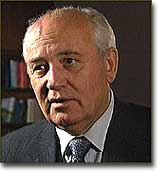
The "glasnost" (openness) and "perestroika" (reform) of Mikhail Gorbachev's term as Soviet Premier led to lessened tensions and a better dialogue between the U.S. and USSR.
Terrorism and anti-Communism combined to confront Reagan with his worst domestic scandal. In November 1986, the press reported that American military supplies had been secretly sold to archenemy Iran in exchange for their support for the release of American hostages held in Lebanon. As the story unraveled, it was revealed that a National Security Council aide namedOLIVER NORTH diverted proceeds from the Iran deal to support the NICARAGUAN CONTRAS, who fought against the Sandinista government.
The Congress had expressly forbidden such aid, but high-level Reagan Administration officials had proceeded nonetheless. Documents were shredded to mask the paper trail in the White House. No connection to between the scandal and President Reagan was ever proven. When asked about his knowledge of the IRAN-CONTRA AFFAIR, Reagan repeatedly replied: "I don't remember." Although no charges were ever raised, the "Teflon President" was somewhat smeared by the ugly mess in the White House.
Life in the 1980s
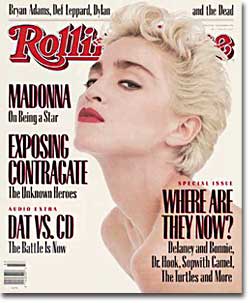
"I want my MTV."
Americans enjoyed many fundamental changes in their standard of living in the 1980s. One major transformation was the new, expanded role of television.CABLE TELEVISION, although available in the 1970s, became standard for most American households. This change ushered in a whole host of new programming.
Sports-minded Americans could watch the ESPN network 24 hours a day. NICKELODEON catered to the children of the baby boomers with youth-centered daily programming, and to the boomers themselves by broadcasting reruns of classic sitcoms at night. Americans could catch up with the news at any time by watching CNN.
MTV, or Music Television, brought a revolution to the recording industry. MTV broadcast music video interpretations of popular songs. Beginning in 1981 with the prophetic Buggles tune "Video Killed the Radio Star," MTV redefined popular music. Stars like MADONNA and MICHAEL JACKSON were much more able to convey an image as well as music. Madonna's "MATERIAL GIRL"message typified the values of an increasingly materialistic decade.
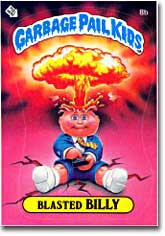
Rude, crude, and with a bad attitude, the "Garbage Pail Kids" collector cards took the U.S. by storm in the 1980s. With names like "Potty Scotty" and "Barfin' Barbara," these kids were a reaction to one of the decades other fads — the Cabbage Patch Kids.
The VIDEOCASSETTE RECORDER (VCR) allowed Americans to record television shows and watch them according to their own schedule and view feature films in the privacy of their own homes.
Perhaps the product that introduced the greatest change in American lifestyles of the 1980s was the PERSONAL COMPUTER. Introduced by APPLE in 1977, the personal computer allowed management of personal finances, quick word-processing, and desktop publishing from the home. Businesses could manage payroll, mailing lists, and inventories from one small machine. Gone were the ledgers of the past. The SILICON VALLEY of California, which was the home to many of the firms that produced the processors that made these computers run, became the symbolic heart of the American technological economy.
"Greed is good," declared the lead character of the movie Wall Street. With the growing economy, many middle-class Americans rushed to invest in the bullish stock market and to flaunt their newly acquired wealth. Young Urban Professionals, or YUPPIES, replaced the socially conscious hippie of the previous generation of youth. Yuppies sought executive track jobs in large corporations and spent their money on upscale consumer products like Ray-Ban sunglasses, Polo apparel, and Mercedes and BMW automobiles. The health and fitness industry exploded as many yuppies engaged in regular fitness routines.
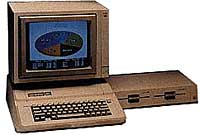
The computing revolution of the 1980s began with the introduction of the Apple II series. Sometimes referred to as the "Model-T" of computers, the Apple II allowed businesses to streamline operations and brought the wonders of digital data management into the home.
The hedonism of the 1970s was being re-evaluated. Many drugs, which were considered recreational in the '70s, were revealed as addictive, deadly substances. As reports of celebrities entering rehabilitation centers and the horrors of drug-ridden inner cities became widely known, FIRST LADY NANCY REAGAN's message to "JUST SAY NO" to drugs became more powerful. Regardless, newer and more dangerous substances like crack cocaine exacerbated the nation's drug problem.
The sexual revolution was rocked by the spread of Acquired Immune Deficiency Syndrome, or AIDS. This deadly disease was most commonly communicated by sexual contact and the sharing of intravenous needles. With the risks of promiscuous behavior rising to a mortal level, monogamy and "safe sex" with condoms were practiced more regularly.
While greed may have been rewarded in the '80s, lust, be it for drugs or sex, proved fatal for thousands.
The End of the Cold War
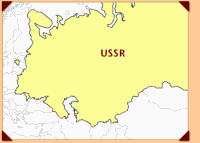
This map charts the change from the single communist nation of the USSR into the confederation of smaller independent nations once dominated by Russia.
The fall of the Berlin Wall. The shredding of the Iron Curtain. The end of the Cold War.
When Mikhail Gorbachev assumed the reins of power in the Soviet Union in 1985, no one predicted the revolution he would bring. A dedicated reformer, Gorbachev introduced the policies of glasnost andperestroika to the USSR.
GLASNOST, or openness, meant a greater willingness on the part of Soviet officials to allow western ideas and goods into the USSR. PERESTROIKA was an initiative that allowed limited market incentives to Soviet citizens.
Gorbachev hoped these changes would be enough to spark the sluggish Soviet economy. Freedom, however, is addictive.
The unraveling of the SOVIET BLOC began in Poland in June 1989. Despite previous Soviet military interventions in Hungary, Czechoslovakia, and Poland itself, Polish voters elected a noncommunist opposition government to their legislature. The world watched with anxious eyes, expecting Soviet tanks to roll into Poland preventing the new government from taking power.
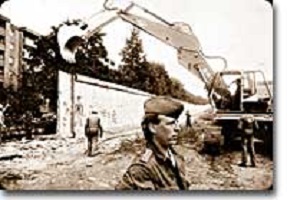
Here, crews of German troops tear down the Berlin Wall. While many had taken axes and picks to the Wall upon the collapse of Communism in Germany in 1989, the official destruction of the Berlin Wall did not begin until June, 1990.
Gorbachev, however, refused to act.
Like dominoes, Eastern European communist dictatorships fell one by one. By the fall of 1989, East and West Germans were tearing down the BERLIN WALL with pickaxes. Communist regimes were ousted in Hungary and Czechoslovakia. On Christmas Day, the brutal Romanian dictator NICOLAE CEAUSESCU and his wife were summarily executed on live television. Yugoslavia threw off the yoke of communism only to dissolve quickly into a violent civil war.
Demands for freedom soon spread to the Soviet Union. The BALTIC STATES of Estonia, Latvia, and Lithuania declared independence. Talks of similar sentiments were heard in UKRAINE, the CAUCASUS, and the CENTRAL ASIANstates. Here Gorbachev wished to draw the line. Self-determination for Eastern Europe was one thing, but he intended to maintain the territorial integrity of the Soviet Union. In 1991, he proposed a Union Treaty, giving greater autonomy to the Soviet republics, while keeping them under central control.
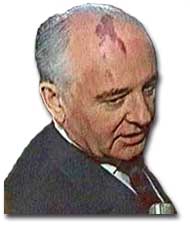
When Mikhail Gorbachev assumed power of the Soviet Union in 1985, he instituted the policies ofglasnost and perestroika in hopes of sparking the sluggish economy. What resulted from this taste of freedom was the revolution that ended the Cold War.
That summer, a coup by conservative hardliners took place. Gorbachev was placed under house arrest. Meanwhile, BORIS YELTSIN, the leader of the RUSSIAN SOVIET REPUBLIC, demanded the arrest of the hardliners. The army and the public sided with Yeltsin, and the coup failed. Though Gorbachev was freed, he was left with little legitimacy.
Nationalist leaders like Yeltsin were far more popular than he could hope to become. In December 1991, Ukraine,BYELORUSSIA, and RUSSIA itself declared independence and the Soviet Union was dissolved. Gorbachev was a president without a country.
Americans were pleasantly shocked, but shocked nonetheless at the turn of events in the Soviet bloc. No serious discourse on any diplomatic levels in the USSR addressed the likelihood of a Soviet collapse. Republicans were quick to claim credit for winning the Cold War. They believed the military spending policies of the Reagan-Bush years forced the Soviets to the brink of economic collapse. Democrats argued that containment of communism was a bipartisan policy for 45 years begun by the Democrat Harry Truman.
Others pointed out that no one really won the Cold War. The United States spent trillions of dollars arming themselves for a direct confrontation with the Soviet Union that fortunately never came. Regardless, thousands of American lives were lost waging proxy wars in Korea and Vietnam.
Most Americans found it difficult to get used to the idea of no Cold War. Since 1945, Americans were born into a Cold War culture that featured McCarthyist witch hunts, backyard bomb shelters, a space race, a missile crisis, détente, the Soviet invasion of Afghanistan, and the Star Wars defense proposal. Now the enemy was beaten, but the world remained unsafe. In many ways, facing one superpower was simpler than challenging dozens of rogue states and renegade groups sponsoring global terrorism.
Americans hoped against hope that the new world order of the 1990s would be marked with the security and prosperity to which they had become accustomed.
